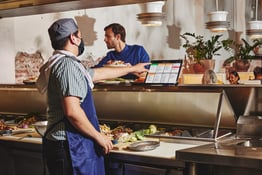Today, the vast majority of restaurants rely on advanced technology platforms to handle a wide spectrum of critical functions. The best technology solutions for restaurants will typically integrate functions like inventory management, payment processing, expense tracking, and much more.
But how can the right restaurant technology platform help you run a more efficient business?
As an industry-leading restaurant app that can integrate with your restaurant’s POS system to streamline inventory management, MarginEdge can track costs, capture receipts, schedule payments, and provide real-time performance data. We spoke with MarginEdge founder and CEO Bo Davis, to dive deeper into why restaurant technology platforms have become essential to the restaurant industry.
You can also check out the whole conversation on Google, Spotify, or Apple.
Restaurant Technology Platforms in a Rapidly Transforming Industry
Restaurant technology platforms have become an essential tool for helping restaurant operators navigate an increasingly challenging business landscape. Profit margins are notoriously tight in the industry, and in the aftermath of the COVID-19 crisis, there is greater uncertainty than ever about critical factors like the reliability of the supply chain, the availability of steady labor, and your restaurant’s mix of revenue streams.
“Revenue changes very much day by day, and your food and your labor are variable – so to try to hit a 10% profit margin day by day is really difficult," Davis told us. "A good restaurant’s doing a couple million in revenue, and spending one and a half million dollars, and it's all variable. It's hard.”
This is why technology solutions for restaurants are increasingly focused on providing real-time data monitoring, advanced analysis, and improved forecasting. Restaurants that leverage advanced technology to cut costs, anticipate needs, and offset operational disruptions while retaining high quality control enjoy a competitive edge in an unpredictable business environment.
5 Ways Restaurant Technology Platforms Increase Efficiency
According to Davis, there are five distinct ways restaurant technology platforms are helping businesses gain this competitive advantage:
1. Operational agility
Though the COVID crisis is in the rearview mirror, restaurant operators have retained many of the important lessons learned during that unprecedented time. In particular, our industry has a renewed appreciation for the importance of moving swiftly, strategically, and decisively.
Davis described, for instance, the serious logistical challenges that dine-in businesses faced during COVID when “having to switch to takeout and delivery – everything from packaging to menu items to pricing to how to take your orders.”
“Naturally,” said Davis, “that forces you to rethink your operations pretty dramatically.”
Thanks to that experience, many restaurants are focused on heightened integration between ordering, payment, and food service processing; enhanced control over pricing, ordering, and menu optimization; and access to refined data for improved decision making. For many restaurants, the events of the last several years have underscored the importance of responding quickly but thoughtfully to sudden changes in the market.
Advanced restaurant technology platforms are making this possible.
2. Real-time data monitoring
As noted above, your restaurant must be capable of adjusting to sometimes rapidly shifting business conditions. This is why a growing number of technology solutions for restaurants now offer user-friendly access to real-time data on menu performance, profit margins, labor costs, and more.
As Davis explains, these data points make it possible to recognize patterns and adjust or adapt accordingly. Platforms like MarginEdge can provide restaurants with the data and insights needed to respond both quickly and intuitively to sudden changes in demand, costs for certain food supplies, or conditions in the broader economy.
3. Inventory tracking
The right restaurant technology platforms can dramatically improve the efficiency and accuracy of your inventory management strategy. Inventory management can be an extremely complex undertaking. Davis explains that “To really know what's going on with all of these things, you're dealing with 50 invoices, from 20 vendors, with 800 items.”
This complexity can lead to human error and, consequently, overstocking, stockouts, and food waste. Today, technology solutions for restaurants typically include features like enhanced controls, automated reordering, and real-time stock level monitoring. These functionalities can streamline your inventory management process and ultimately cut down significantly on excess costs.
4. Advanced data processing
Restaurant technology platforms are helping restaurant operators reduce both the labor burden and susceptibility to error common with traditional methods of data entry and analysis. With MarginEdge, for example, your restaurant can submit photos of your invoices directly to the platform. The data from these photos is processed through a combination of machine learning and human quality control.
Davis pointed out that this method makes it possible to keep inventory and recipe prices continuously up-to-date. In fact, Davis noted that MarginEdge allows users to map out price movements on visual charts, quickly spot items with shrinking margins, and “make adjustments before you realize you're losing money.”
5. Enhanced forecasting
In recent years, we’ve seen significant advancements in AI, machine learning, and automation capabilities. Davis anticipates that these technologies will play an increasingly important role in refining financial forecasting for restaurants.
“All software is going to move from reporting to predicting,” observed Davis, “but certainly in the restaurant business – predicting what people will sell down to the item level, and then from that, doing dynamic inventory and dynamic ordering so that when you walk into a restaurant as a kitchen manager, as a chef, you can focus on the quality control aspects and the preparation of food.”
Finding the Right Restaurant Technology Platform
There's no one-size-fits-all approach to choosing the right technology platforms for your restaurant. The best way to approach restaurant technology is to think about your goals, needs, challenges, and budget and pick a best-fit solution.
If you're not sure where to start, visit our vetted third-party marketplace to browse the best restaurant technology platforms in the industry today. From enhanced inventory management and advanced data analytics to AI-powered hiring applications and data-driven marketing, Back of House has you covered.





